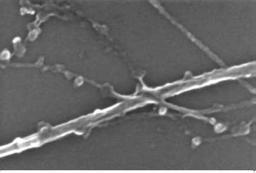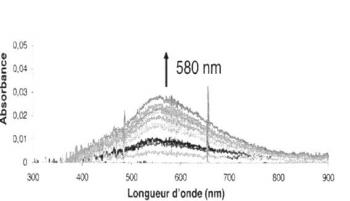Patents 2012
Numéro d’identification : WO/2013/120907 (lien OMPI)
Numéro d’identification CEA BD 13329
Année de publication 22.08.2013
Année de dépôt: 13.02.2012
Procédé de fonctionnalisation de nano-objets en carbone, composition comprenant des nano-objets en carbone fonctionnalisés en suspension dans un solvant organique et ses utilisations
L'invention se rapporte à un procédé permettant de fonctionnaliser des nano-objets en carbone et, en particulier, des nanotubes de carbone et des nanofeuillets de graphène, à une composition comprenant des nano-objets fonctionnalisés par ce procédé, en suspension dans un solvant organique, ainsi qu'aux utilisations de cette composition. Applications : élaboration de matériaux composites et, en particulier, de matériaux nano-composites, de matériaux destinés au photovoltaïque, de dispositifs de détection du type capteurs/senseurs ou biocapteurs/biosenseurs, de systèmes de photocatalyse, de systèmes de vectorisation ciblée de composés d'intérêt thérapeutique ou diagnostique ou encore d'agents de contraste pour l'imagerie médicale.
Method for functionalising carbon nano-objects, composition comprising functionalised carbon nano-objects in suspension in an organic solvent, and uses thereof the present (WIPO link)
The invention relates to a method for functionalising carbon nano-objects and, in particular, carbon nanotubes and graphene nanosheets, to a composition comprising nano-objects functionalised by this method, in suspension in an organic solvent, and to the uses of said composition. Applications: the development of composite materials and, in particular, nano-composite materials, materials intended for photovoltaics, sensor or biosensor detection devices, photocatalytic systems, systems for the targeted delivery of compounds of therapeutic or diagnostic interest, or indeed contrast agents for medical imaging.
Contact: S. Campidelli.
Numéro d’identification international: WO/2012/110914 (lien OMPI)
Numéro d’identification CEA : BD 12398
Date de dépôt : 14-02-2011
Date de publication: 23-08-2012
Dispositif de synthèse d'un matériau composite nanostructure et procédé associé.
La présente invention concerne un dispositif de synthèse d'un matériau composite nanostructuré et un procédé associé. Le dispositif comprend une chambre de synthèse (3) dudit matériau comportant un système (13) de dépôt de la matrice sur une surface cible (15), un système (1, 4, 5, 9) pour générer un jet supersonique de nanoparticules dans un gaz porteur, ledit système comportant une chambre de détente (1 ) et une chambre tampon (2) disposée entre ledit système (1, 4, 5, 9) pour générer ce jet supersonique et la chambre de synthèse (3), la pression régnant dans la chambre tampon (2) étant inférieure à la pression régnant dans la chambre de détente (1 ), ledit jet supersonique de gaz porteur entraînant les nanoparticules étant ainsi destiné à traverser la chambre de détente (1 ) puis la chambre tampon (2), de sorte que les nanoparticules traversent la chambre de synthèse (3) jusqu'à la surface cible (15)
Device for synthesising a nanostructured composite material, and associated method (WIPO link)
The present invention relates to a device for synthesising a nanostructured composite material and to an associated method. The device includes a chamber (3) for synthesising said material, comprising a system (13) for depositing the matrix onto a target surface (15), a system (1, 4, 5, 9) for generating a supersonic jet of nanoparticles in a carrier gas, said system comprising an expansion chamber (1) and a buffer chamber (2) arranged between said system (1, 4, 5, 9) for generating said supersonic jet and the synthesis chamber (3), the prevailing pressure inside the buffer chamber (2) being lower than the prevailing pressure inside the expansion chamber (1), said supersonic jet of carrier gas driving the nanoparticles which are to thereby pass through the expansion chamber (1) and then through the buffer chamber (2), such that the nanoparticles pass through the synthesis chamber (3) onto the target surface (15).
Contact: Y. Leconte.
Numéro d’identification international: WO/2012/080665 (lien OMPI)
Numéro d’identification CEA : BD 12241
Date de dépôt : 16-12-2010
Date de publication: 21-06-2012
Détecteur multifonctionnel de composés gazeux et ses applications
Détecteur multifonctionnel de composés gazeux ou mélanges de composés gazeux choisis parmi NH2Cl, NHCl2, NCl3, chlore total, NOx où x=1 ou 2, O3 et X2 où X=Cl, Br ou I dans un échantillon, ledit détecteur comprenantun premier capteur comprenant un iodure et un composé réactif choisi parmi l'amidon, l'amylose, l'amylopectine, le xyloglucane, le xylane, le chitosane, le glycogène, l'alcool polyvinylique ou un composé de l'alcool polyvinylique, la cellulose ou un composé de la cellulose, l'α-cyclodextrine, la théobromine et les polymères blocs d'oxydes de polypropylène et de polyéthylène, incorporés dans un bloc de matériau sol-gel absorbant dans l'UV mais pas dans le visible, et ses applications.
Multifunctional detector for gaseous compounds, and uses thereof (WIPO link)
The invention relates to a multifunctional detector for gaseous compounds, or mixtures of gaseous compounds, selected from NH2Cl, NHCl2, NCl3, total chlorine, NOx, where x=1 or 2, O3, and X2, where X=Cl, Br, or I, in a sample, said detector including a first sensor including an iodide and a reactive compound selected from starch, amylose, amylopectin, xyloglucan, xylan, chitosan, glycogen, polyvinyl alcohol, cellulose or a cellulose compound, α-cyclodextrin, theobromine, and polypropylene block polymers and polyethylene oxide block polymers, included in a block of sol-gel material that is absorbent in the UV spectrum but not in the visible spectrum. The invention also relates to the uses of said detector.
Contact: T.-H. Tran-Thi.












